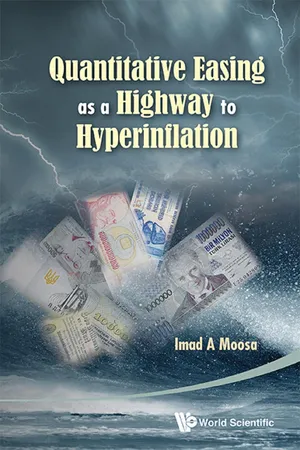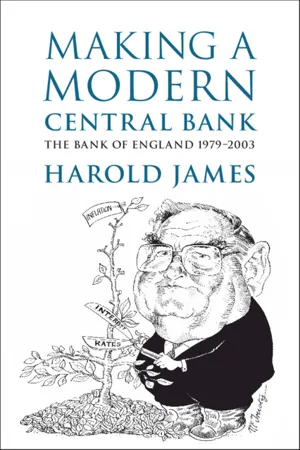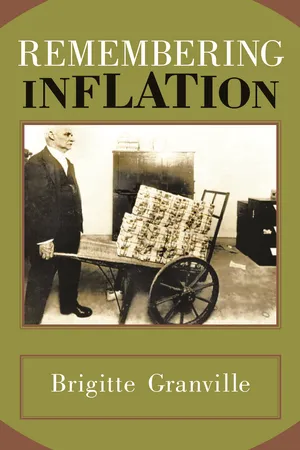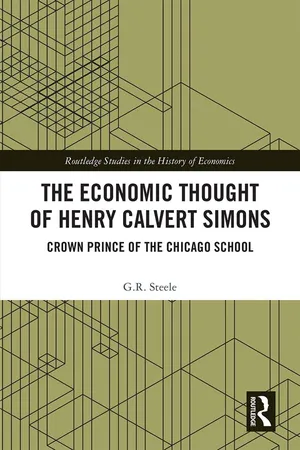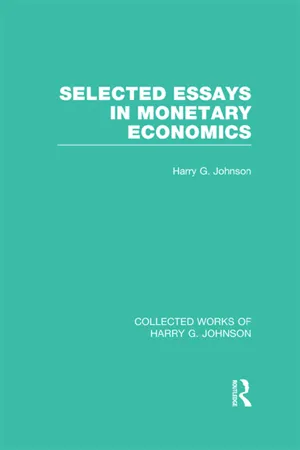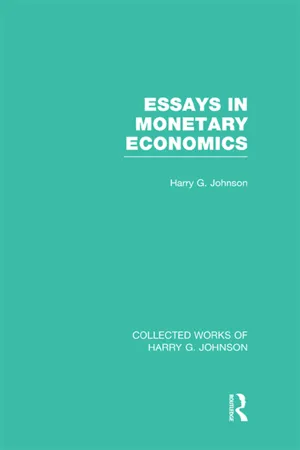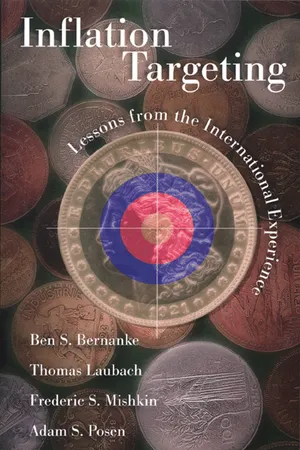Economics
Monetarist Theory of Inflation
The Monetarist Theory of Inflation, associated with economist Milton Friedman, posits that inflation is primarily caused by an increase in the money supply. According to this theory, when the government prints more money, it leads to an excess of money in the economy, driving up prices. Monetarists advocate for controlling inflation by regulating the growth of the money supply.
Written by Perlego with AI-assistance
Related key terms
1 of 5
10 Key excerpts on "Monetarist Theory of Inflation"
- Imad A Moosa(Author)
- 2013(Publication Date)
- WSPC(Publisher)
Chapter 3 THE MONETARY THEORY OF INFLATION 3.1.IntroductionThe idea behind the monetary theory of inflation is simple. If more money is created than what is required to buy goods and services, prices will rise — that is, the value of money in terms of goods and services (or the purchasing power of money) will decline. Inflation, in other words, arises when too much money chases too few goods. In the 19th century, the relation between the money supply and inflation was articulated by Joplin (1826) as follows:There is no opinion better established, though it is seldom consistently maintained, than that the general scale of prices existing in every country, is determined by the amount of money which circulates in it.In the 20th century, Milton Friedman appeared as the most outspoken advocate of the monetary theory of inflation. A famous quote from Friedman that is often repeated in the literature and the media is that “inflation is always and everywhere a monetary phenomenon” (Friedman, 1963).An increase in the quantity of money is typically taken to be synonymous with the debasement of the medium of exchange. Episodes of debasement have occurred throughout history and involved different forms of money. For example, when gold was used as a currency, the government could collect gold coins, melt them down, mix them with cheaper metals (such as silver, copper or lead), and re-issue them at the same nominal value. By diluting gold with other metals, the government could issue more coins without increasing the amount of gold required to make them. The government profits from an increase in seigniorage (which is the difference between the nominal value of a coin and the cost of producing it), when the cost of producing coins is reduced in this way. As a result, the value of coins declines in terms of goods while goods’ prices rise, which means that monetary inflation leads to price inflation.- eBook - PDF
Making a Modern Central Bank
The Bank of England 1979–2003
- Harold James(Author)
- 2020(Publication Date)
- Cambridge University Press(Publisher)
Strictly speaking, monetarism refers to the policy of using a measure of a monetary aggregate in order to generate a policy response with the aim of controlling price developments so as to reduce or eliminate inflation. In practice, however, the concept was often used in a restricted – and in reality perhaps often even contradictory – manner, as relating to a restrictive approach to fiscal policy. In the first and general sense, monetary control looked like a profound shock to the central worldview of what the Bank of England’s John Fforde liked to describe as Britain’s ‘macro-economic executive’, because there was no obvious mechanism to force an aggregate on a system which worked by responding to banks’ demands for funds; but also because after the failure of the prices and wages policies of the 1970s, the authorities began to see price behaviour as driven by a complex social process with which they did not want to tamper. But in the second nar- rowly fiscal sense, it could be accommodated within a sort of common- sense view that was really deeply entrenched in the Treasury mindset – though it would then decidedly not provide a substantive foundation for making monetary policy. The doctrine also appealed to a government that was averse to using an explicit interest rate policy because of political concerns about the effects of high interest rates on mortgage payments in a country with a high level of homeownership. RESPONDING TO INFLATION Monetarism was a response to failure: both to the political flaws of a policy process and to the theoretical flaws of an explanatory mechan- ism. The central and correct insight of monetarism was that the inflation of the 1960s and 1970s was driven by demand, and that there was over the long run a clear link between the growth of money and the development of prices, and no clear association between higher output and higher levels of monetary growth. - eBook - PDF
- Brigitte Granville(Author)
- 2013(Publication Date)
- Princeton University Press(Publisher)
Milton Friedman (1968: 12) observed that “every major inflation has been produced by monetary expansion—mostly to meet the overriding demands of war which has forced the creation of money to C H A P T E R 2 34 supplement explicit taxation.” But the story does not end there. This sec-ond chapter turns to subsequent important developments in economists’ thinking on the origins of inflation. These new ideas, which first emerged in the early 1980s and were elaborated during the following two decades, demonstrated that tighter monetary policy is not a sufficient condition for controlling the rate of inflation. For this purpose of examining the roots of inflation, one-off price in-creases may be ignored. Such increases may be due to an external shock such as an increase in the price of oil or other commodities, and which for a limited period may have an effect on the price index depending on the weight of these commodities in the domestic basket used for the calcula-tion of the percentage change in the price level. An increase in VAT is an example of the several other kinds of shocks that can have a material short- term effect on “inflation” in the sense of the price index. Throughout history since the invention of money, inflation has been an elusive phenomenon. Money improved on barter both by making trading exchanges more efficient and by creating a means of savings. It also allowed exchange and saving to be easily accounted for. These attributes and the utility of money are impaired by inflation, which reduces the quantity of goods or services that can be bought with the same amount of money over a certain period of time. When money was a commodity itself, such as gold, silver, or copper, discovery of new deposits led to inflation. The monetary coinage was often debased to finance spending when taxes proved insuffi-cient to finance wars, monuments, or other projects. Such has been the im-memorial practice of spendthrift rulers and regimes of all kinds and times. - eBook - PDF
- G.R. Steele(Author)
- 2018(Publication Date)
- Routledge(Publisher)
This statement was so distinct from Keynesianism that it became necessary to invent a new label for such an idea. In 1968, Karl Brunner called it ‘monetarism’ and the name stuck. (Foster, 1987, p. 42) It was only then that the Keynesian orthodoxy encountered the full force of the Monetarist counter-revolution. Monetarism and Fiscal Monetarism 109 8.2 The quantity theory of money Monetarism: the novelty of a new name tends to obscure its relevant an-tecedents. The basic idea is that price inflation is determined by the prior excessive growth of money. Alternatively stated, inflation is currency de-basement. However, the quantity theory of money has invited considera-ble inventiveness and embellishment since attention was first taken by the impact of money upon trade and industry. Which are the key transmission mechanisms between money and prices? Friedman’s ‘The Quantity Theory of Money. A Restatement’ (Friedman, 1956) describes a transmission based upon adjustments to portfolios of financial assets – i.e., the exact same mech-anism upon which Keynes bases his liquidity preference theory of interest rate determination. By Keynes’s presentation, with an economy at under-full employment, the liquidity preference theory of interest rate determination is held to be more plausible than the classical loanable funds theory. 2 Although the basic idea of the quantity theory of money is traceable to ancient times, an early ‘theoretically satisfactory presentation’ (Schumpeter, 1954, p. 311) is credited to Jean Bodin (1568); but it was John Stuart Mill (1848) who brought precision to the idea: If we assume the quantity of goods on sale, and the number of times these goods are resold, to be fixed quantities [ T ] the value of money [1/ P ] will depend upon its quantity [ M ], together with the average number of times that each piece changes hands in the process [ V ]’. - eBook - PDF
- R. Leeson(Author)
- 2010(Publication Date)
- Palgrave Macmillan(Publisher)
These, he argued, reflected both finan- cial innovation (which could have been adjusted to) and changes in regulations which, in turn, were a consequence of the buildup of inflation before the mon- etarist experiment (Laidler, 1997 a). A more important problem was the way in which the Bank of Canada and other central banks hit their monetary aggregate targets. Rather than follow the mon- etarist prescription of using the monetary base to hit their money growth targets, which Laidler calls “active money,” central banks followed “passive money.” They used their estimates of the short-run demand for money function (based on the Goldfeld specification) to solve for the short-term interest rate needed to hit their stated money target. This made money supply endogenous and responsive to whatever shocks would drive the demand for bank credit (Laidler, 1999). Finally, he criticized the original monetarist approach to inflation, which focused on the influence of expected inflation on money demand (Laidler, 1997b). According to that view the costs of expected inflation were trivial, and hence could be easily dealt with by a gradualist policy. This approach ignores money’s role as unit of account and medium of exchange and the distortions inflation imposes on the payments and accounting systems (Laidler, 1997b, 2003). Despite his later criticism of the early monetarist approach to policy rules, he continued throughout his career to emphasize the basic monetarist principle that inflation is a monetary phenomenon. Moreover, now that monetary policy is being conducted in most advanced countries without the explicit use of any mon- etary aggregates, Laidler warns that conducting monetary policy without money is like having “Hamlet without the Ghost” – that monetary aggregates convey information about the transmission mechanism that is crucial to the effective conduct of policy (Laidler, 2003). - Harry Johnson(Author)
- 2013(Publication Date)
- Routledge(Publisher)
1 It is possible to detect some redistribution among particular groups; but for this type of model to be proved useful for the analysis of inflation, it would be necessary to establish that the inflationary mechanism works by redistributing income among major income-receiving groups. This in turn would require that some of such groups be unable or unwilling to protect their real incomes from the impact of inflation; in fact, on the contrary, such protection is available to all groups in a freely competitive system, through negotiation of contracts to take account of expected inflation, and is increasingly resorted to as the fact of inflation is recognized. Consequently the Keynesian approach to inflation in terms of income redistribution seems less satisfactory than the alternative quantity theory approach to which I now turn, an approach which concentrates on the effects of inflation on wealth rather than on real income and its distribution.IV. THE QUANTITY THEORY APPROACH TO INFLATIONThe quantity theory approach to inflation differs essentially from that of the Keynesian models just discussed in the basic assumptions from which it starts: instead of assuming that wage changes provoke price changes and conversely through institutionally given (and therefore arbitrary) reaction coefficients it assumes that in an inflation the economy becomes accustomed to the expectation of continued inflation, so that the processes of determining wages and prices are fundamentally real processes and not arbitrary processes determined exogenously. The basic postulate of the quantity theory models of inflation is that there is a stable demand function for money in real terms, into which the rate of inflation enters as a cost of holding real balances, which cost influences the quantity of real balances held. Given this function, the rate of increase of the nominal stock of money determines the rate of inflation, the public eventually coming to expect that rate of inflation and adjusting its stock of real balances (or ratio of real balances to real income) to it. In order to maintain its real balances constant in the face of inflation, the public must accumulate money balances at a rate equal to the rate of inflation; this accumulation of money balances in order to preserve real balances is achieved at the cost of sacrificing the consumption of current real income in order to maintain real balances intact, the release of current real income constituting the equivalent of a ‘tax’ on the holders of real balances; the tax on real balances, in turn, accrues as revenue to the beneficiaries of the inflationary increase in the money supply.1- Harry Johnson, Harry G. Johnson(Authors)
- 2013(Publication Date)
- Routledge(Publisher)
The first, which I have already developed in criticism of the Keynesian inflation models, relates to the failure of the disputants to investigate the monetary assumptions on which the rival theories were based. Neither cost-push nor demand-pull inflation models can generate a sustained inflation unless it is assumed either that the demand for money can be compressed indefinitely without adverse effects on demand and employment, which runs contrary to the theory and fact of monetary behaviour, or that the monetary authority permissively provides the additional money required to circulate the national income at ever-increasing prices, in which case the behaviour of the monetary authority becomes the crucial factor in the inflation (and, in addition, the question arises for the cost-push theory as to what determines the pace of inflation). The two theories are therefore not independent and self-contained theories of inflation, but rather theories concerning the mechanism of inflation in a monetary environment that permits it. The real issue between them, therefore, was an issue of policy; whether inflation could be stopped by attacking the mechanism of cost and price determination or whether it could only be stopped by attacking aggregate demand. In the second place, the argument was in large part based on differences between the two theories in their definitions of full employment. To elaborate on this, consider the curve shown in Figure 2, which expresses the proposition that the rate of price change in the economy is a function of the percentage of unemployment, prices being stable at the unemployment rate B. Now if ‘full employment’ is defined as existing when the demand for goods is just sufficient to prevent prices from either rising or falling—that is, defined by the point B—it follows as a mere tautology that inflation must be associated with excess demand for goods and labour or ‘over-full’ employment- eBook - PDF
- J. King(Author)
- 2008(Publication Date)
- Palgrave Macmillan(Publisher)
In lectures at the University of Wales (Kaldor 1981a) and Warwick University, and in evidence to the Treasury and Civil Service Committee (published together in Kaldor 1982a), he criti- cised the theoretical basis of monetarism in a more considered and more comprehensive way than he had done in 1970. There were four principal elements in his attack. First, he made a great deal of the important distinction between commodity money and credit money: The Quantity Theory had been devised at a time when ‘money’ meant gold and silver: For the modern monetarists, however, the theory is applied not to commodity money but to credit-money; in other words, to money which consists of the I.O.U.s (or ‘promises to pay’) of the central bank and of the clearing banks which provide facilities of drawing on accounts by means of transferable certificates of debt (of which The Scourge of Monetarism 145 ‘ cheques’ are the most common example). Such credit money has no ‘supply function’ in the production sense (since its costs of produc- tion are insignificant if not actually zero); it comes into existence as a result of bank lending and is extinguished through the repayment of bank loans. (Kaldor 1981a, p. 15) It followed that the monetarists were quite wrong to claim that inf la- tion was caused by an excess supply of money, which economic agents hastened to dispose of by spending it. In a credit-money system there could be no such excess supply: If ... more money comes into existence than the public, at the given or expected level of incomes or expenditures, wishes to hold, the excess will be automatically extinguished – either through debt repay- ment or its conversion into interest-bearing assets – in a way in which gold could not be made to disappear from existence merely because particular persons find that they have too much of it. They can pass it on to others, but if they have less, others will have more. - eBook - PDF
- Meghnad Desai(Author)
- 2013(Publication Date)
- Bloomsbury Academic(Publisher)
68 Quantity Theory to Monetarism which form the core of the revival of the quantity theory. These relate to the stability of the demand for money over the long run, the relatively greater stability of the money demand function compared to the con-sumption function and hence the larger the size of the money mulitplier compared to the fiscal multiplier, the long and variable lags in the short run between changes in money stock and changes in real income and prices, the independent nature of changes in money stock and its causal primacy vis-a-vis changes in income and prices, the limits to fine tuning due to the imprecision of lags, the desirability of a fixed money growth rule with no feedback mechanism. Considerable controversy has surrounded each of these points and a large body of economic research can be cited on either side of each question. For our present purpose, we need to note that much of what was being asserted was empirical rather than theoretical. Friedman did not have, as yet, a fully fledged theory of the ways in which money affected output and prices. The empirical regularity of the relationship between money and nominal income was only strong in the secular context, the cyclical relationship being blurred and hedged by qualifications about the feedback from income to money. Even if Friedman's empirical assertions were to be admitted as true (and they were not), critics could still say that this did not amount to an explanation of how money affected economic activity. In the ranking order used by academic economists (and, I suspect, by researchers in other sciences) a theoretical model ranks much higher than 'mere' empirical evidence. Where was 'the trans-mission mechanism'? Even from the point of view of a quantity theorist, the Friedman story was incomplete. The traditional basis for the support the quantity theory has received has been that excess money (debauched currency) causes inflation and attendant economic and political crises. - eBook - PDF
Inflation Targeting
Lessons from the International Experience
- Ben S. Bernanke, Thomas Laubach, Frederic S. Mishkin, Adam S. Posen(Authors)
- 2018(Publication Date)
- Princeton University Press(Publisher)
N o r d i d inflation vanish: The late 1960s and the decade o f the 1970s were plagued w i t h rising and variable rates o f inflation, i n the U n i t e d States and i n many other countries as well. Further, i n the view o f most economists, the se- vere 1981-82 recession was largely the result o f restrictive monetary policy, which i n t u r n had been made necessary by surging inflation. I n short, the activist monetary policies o f the 1960s and 1970s not only failed to deliver their promised benefits, they helped to generate inflationary pres- sures that could be subdued only at h i g h economic cost. Intellectual developments, too, have contributed to the fading repu- tation o f strongly activist policies. Three such developments have been particularly influential: (1) M i l t o n Friedman's monetarist critique, par- 12 C H A P T E R 2 ticularly his observation that monetary policy works only w i t h "long and variable lags"; (2) the conclusion, reached first by Friedman and E d m u n d Phelps, that there is no long-run tradeoff between inflation and unemployment; and (3) increased understanding o f the potential importance o f central bank credibility to the effectiveness o f monetary policy. Friedman, the founder o f the school o f macroeconomic t h o u g h t k n o w n as monetarism, never doubted that monetary policy can have pow- erful effects o n the economy. H e documented this claim extensively i n his path-breaking book, A Monetary History of the United States, 1867-1960, co-authored w i t h A n n a J . Schwartz. But Friedman also argued that those effects set i n only w i t h lags that are b o t h long and variable (that is, vary- i n g f r o m episode to episode i n essentially unpredictable ways). Conse- quently Friedman argued that monetary policy, though powerful, is not a tool that can be used w i t h precision.
Index pages curate the most relevant extracts from our library of academic textbooks. They’ve been created using an in-house natural language model (NLM), each adding context and meaning to key research topics.
